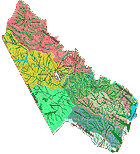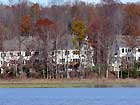A major part of Prince William County's commitment to its citizens is ensuring that environmental resources, including clean water, arguably our most important resource, are protected for current and future generations.
Currently poorly planned development and lax enforcement of environmental safeguards are threatening the health of our waterways, including the Occoquan Reservoir, the region's drinking water supply. The Occoquan Reservoir is already on the EPA's ‘Dirty Waters' list and its condition continues to decline, posing a direct threat to the cleanliness of your drinking water. While protecting the watersheds that are critical to the health of the Occoquan Reservoir is both affordable and practical, once the damage has been done the costs to you as a taxpayer will be astronomical.
Prince William and the Chesapeake Bay Clean Up
Virginia has promised to clean up the Chesapeake Bay by 2010, a responsibility that is shared by Prince William County. No one argues that the Bay doesn't need to be saved, but lack of action even within our own county is not only ensuring that the Chesapeake Bay will not be restored but, just as is the case for the Occoquan Reservoir, that the price tag will grow. State officials currently estimate it will cost Virginia 's taxpayers $2.34 billion to save the Bay.
Prince William has both the tools and the obligation to address this issue. One of the most important tools granted to local Virginia governments is the abililty to protect waterfront land, also known as Resource Preservation Areas, from clearing and other destruction. These waterfront buffers are our last and best defense to prevent pollution from entering our water. Preserving this land is crucial to protecting both our drinking water supply in the Occoquan Reservoir and cleaning up the Chesapeake Bay.
So far the county has avoided this responsibility, even when illegal damages have persisted for years. One county official was reported in a recent Washington Post article as stating that “Although state law allows jurisdictions to impose fines as high as $10,000 for violations, the county does not fine ... ”
Unresolved Violations Cause Unnecessary Impacts and and Increase Taxpayer-Funded Repairs
County efforts to work with developers and homeowners to resolve problems is an effective and positive approach. The Washington Post article quotes Watershed Management Chief Wade Hugh saying that the numbers of violations were not immediately available, but "it's safe to say that we are seeing an increasing trend."
When cooperative efforts fail, localities can take advantage of the authorities granted by the state to ensure that damages are restored or mitigated in a timely manner, without having to resort to a lawsuit. Supervisor Nohe's July 26 2005 initiative directing staff to review these authorities and opportunities is an important step in the right direction toward ensuring that community resources, including the Occoquan Reservoir, are protected.
The Commonwealth of Virginia provides localities with the authority to to pursue enforcement actions at increasingly greater levels of severity until all violations are resolved in a timely manner.
The result of this policy of inaction is that when a developer or individual landowner does not restore shoreline damages, the county does not use the enforcement tools at its disposal. This sends a clear message to developers, citizens and neighbor jurusdictions that the county is not committed to protecting our health, drinking water or our natural heritage.
Currently many violations dating back to 2002 remain unresolved. Click here to read more about some of these problems that were identified by the County as long ago as January 2002 that remain unresolved in July 2005.
Land uses and water quality are directly connected.
Numerous studies show that, when impervious surfaces exceed 10%, waterways are impacted to a degree they can no longer support a full range of aquatic life.
This is perhaps especially important in Prince William because nearly 40% of Prince William County lands drains directly into our public drinking water supply, the Occoquan Reservoir, before flowing to the Potomac River and on to the Chesapeake Bay.









